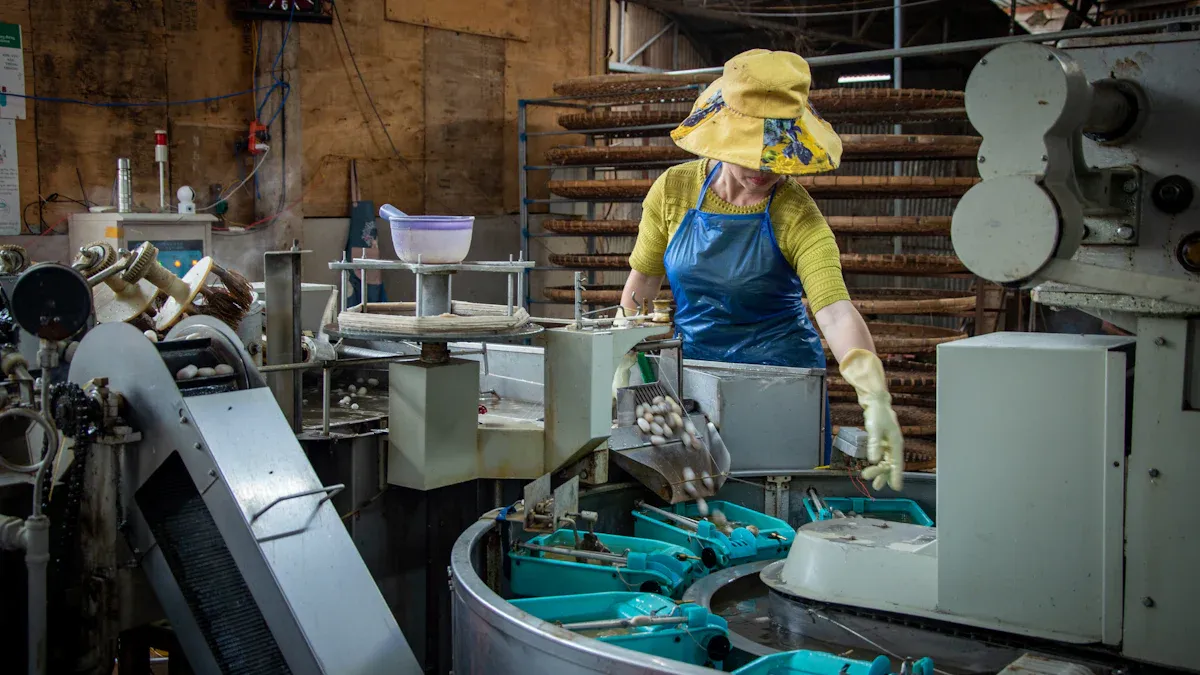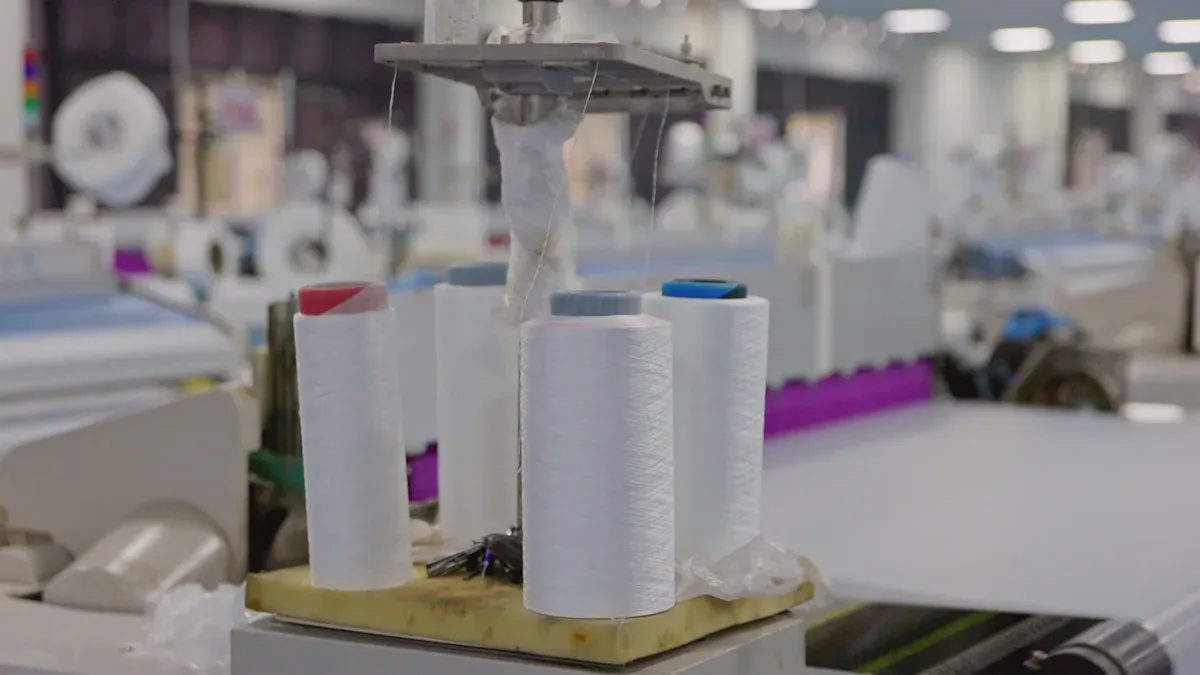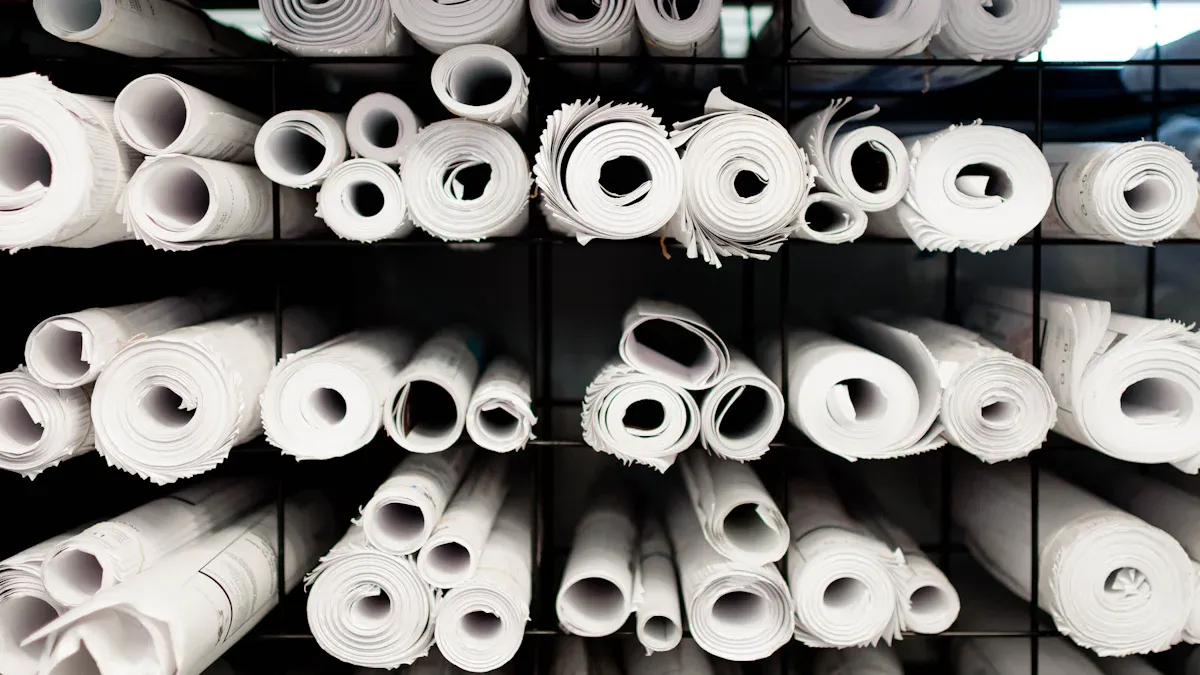close
Choose Your Site
Global
Social Media
Views: 0 Author: Site Editor Publish Time: 2025-07-14 Origin: Site












The tissue industry is evolving as demand for tissue paper continues to grow. The tissue paper market is projected to reach US$ 63.2 billion by 2025.
| Metric | Value | Year/Period |
|---|---|---|
| Global tissue paper market value | US$ 63.2 billion | 2025 |
| Projected CAGR | 3.6% | 2025-2033 |
Innovations in parent roll and tissue paper roll manufacturing enhance quality, support environmental sustainability, and increase efficiency. Huaxin Global Co., Ltd. leads the industry with premium tissue paper raw materials. Their advanced technology and rigorous quality control produce parent rolls and tissue rolls that are soft, strong, and eco-friendly. These advancements improve tissue paper products and benefit a wide range of businesses.
Tissue paper is better when made with good raw materials like certified wood pulp and recycled fibers. These help the tissue stay soft, strong, and good for the environment.
Special fiber treatments and pulping methods help tissue paper soak up water, feel soft, and last longer.
Careful sheet making, wet creping, and drying make tissue softer and thicker. These steps also help keep the tissue strong.
Strong quality checks and eco-friendly ways make sure tissue paper is safe, high-quality, and good for nature.
Customization and private label services help brands make special tissue products. They can choose different packaging and get fast delivery around the world.
Getting raw materials for tissue paper is very important. It affects how good and eco-friendly the tissue paper will be. Top companies like Huaxin Global Co., Ltd. choose wood pulp from forests that are certified. In Europe, most tissue paper uses recycled and new fibers from forests that are managed well. Certifications like FSC and PEFC show that most wood and pulp follow strict green rules. This helps protect forests and keeps land healthy.
Manufacturers have some problems finding green raw materials. They need to mix hardwood and softwood pulp to make tissue both strong and soft. Good recycled fiber is harder to get now. To keep supplies steady, companies work closely with their suppliers. Some companies try using bamboo or bagasse to help with shortages and stay eco-friendly. Checking where wood pulp comes from with certificates and visits is important for trust.
Note: Using green sources helps the planet and makes tissue brands look better to people who care about the environment.
How raw materials are prepared changes how soft, strong, and absorbent tissue paper is. Makers pick hardwood pulp for softness and softwood pulp for strength. Some use non-wood fibers like wheat straw for a greener choice. The pulping process turns wood chips or other fibers into a soft, wet pulp by taking out things that are not needed. Mechanical pulping makes rougher pulp, but chemical pulping removes lignin for cleaner pulp. Biopulping uses tiny living things for a green process.
After pulping, refining makes fibers bendy and helps them stick together. This changes how soft and absorbent the tissue is. Bleaching takes away color and makes the pulp brighter, while keeping fibers strong. Quality control checks every step to keep pulp quality the same. More refining makes tissue stronger but can make it less soft and less absorbent. Enzymes used before refining can make tissue stronger and use fewer enzymes. These steps help raw materials become just right for making good, green tissue paper.

The pulping process is very important in making tissue paper. This step changes raw fibers into pulp. The pulp can be made into soft, strong, and absorbent tissue. Every step in making tissue paper affects how good the parent roll will be.
Fiber treatment helps decide if tissue is soft, strong, or absorbent. Makers pick and mix fibers like virgin pulp or recycled paper. They do this to get the right feel and strength. The process starts with fiber prep. Here, they choose hardwood pulp for softness or softwood pulp for strength. Then, they blend the pulps.
Enzymatic treatment uses cellulase enzymes to break down some cellulose fibers. This makes fibers bend easier and tissue feels softer but stays strong.
Ultrasound pretreatment uses heat and pressure on fibers. This green method helps enzymes work better and makes tissue even softer.
Makers add commercial biopolymer additives and micro/nanofibrillated cellulose to the mix. These help tissue get stronger and soak up more water. This keeps tissue soft but tough.
Dry strength resins, like FennoBond™ and FennoRez™, make tissue stronger when dry. These resins mean less refining is needed, so tissue stays thick and soft.
Biobased softeners, like those in the FennoSoft™ line, are sprayed on wet or dry tissue. These softeners make tissue feel nicer without making it weaker.
Through-Air Drying (TAD) technology dries wet tissue with hot air. This keeps the fiber shape and makes tissue softer and thicker.
Creping control technologies use special adhesives. These help balance softness and strength by letting tissue stick and peel well during making.
Note: Using the right fiber treatments lets makers create tissue that is soft, strong, and absorbent.
Adding chemicals is also a big part of making tissue paper. The chemicals used in pulping change how strong, bright, and green the tissue is.
Sodium hydroxide and sodium sulfide are used in kraft pulping. These break down lignin, which holds fibers together, so the pulp gets strong.
Anthraquinone is sometimes added to help remove lignin faster. It also helps keep more good stuff in the pulp, making it better.
Polysulfide ions help keep carbohydrates safe. This means more pulp is made and fibers stay strong.
In chemimechanical pulping, sodium carbonate, sulfite, and bisulfite change wood parts. These chemicals make fibers soak up more water and stick together better, so tissue is stronger.
Bleaching agents like peroxides, hydrosulfites, and chlorine dioxide make pulp brighter. Chlorine dioxide is often picked because it makes pulp bright but does not make it weak.
Enzymes like lignin peroxidase are used in biopulping. These help break down lignin, make pulp brighter, use fewer chemicals, and make tissue stronger and greener.
Makers must watch what chemicals they use and how much. The right mix keeps tissue strong, soft, and absorbent. It also helps meet green rules.
The making process has many steps:
Fiber prep: Pick and mix fibers for the right tissue.
Pulping: Mix fibers with water and break them into a wet mix.
Papermaking: Put the mix on a machine to make a long tissue sheet.
Calendering: Smooth and press the tissue to make it even and thick.
Reeling: Roll the finished tissue onto big parent rolls.
Quality checks: Test thickness, strength, absorbency, and look.
New pulping tech and machines help use raw stuff better, waste less, and work faster. These new ways save money and keep tissue quality the same. Companies like Huaxin Global Co., Ltd. use these smart methods. They make high-quality tissue parent rolls for today’s needs.

The sheet formation step is important for tissue paper quality. New machines help spread fibers evenly and make the sheet smooth. Special fabrics and rolls help fibers line up better. This lowers mistakes in the sheet. Computers and sensors keep the process steady and the same every time. Quality systems watch the sheet all the time and let workers fix problems fast. Technologies like Advantage DCT, NTT, QRT, eTAD, and ThruAir help fibers stick together. They also make the sheet thicker, softer, and better. Better controls and machine parts help keep more fibers and make a good sheet.
Wet creping and drying make tissue paper soft and able to soak up water. The table below shows what happens during this step:
| Aspect | Effect of Wet Creping and Drying Process |
|---|---|
| Fiber Web Structure | Creping bends and twists fibers, makes layers, and forms folds. |
| Texture (Softness) | Tissue gets softer from fiber changes and folds; heat drying makes it even softer. |
| Absorbency | More fiber ends and folds help tissue soak up more water. |
| Tensile Strength | Tissue gets weaker but feels softer and soaks up more. |
| Fiber Type Influence | Short, thin fibers bend and fold well; long, thick fibers do not. |
| Wet Pressing and Dryness | Pressing makes the sheet tighter; pulp and fiber treatment change how dry and open it is. |
| Process Optimization | Picking the right pulp and fiber treatment saves energy and makes tissue drier. |
After drying, tissue paper goes to rolling and handling. This step keeps the parent roll strong and good. Good ways to handle the rolls include:
1. Stand parent rolls up so they do not get flat.
2. Keep rolls away from chemicals so they do not get ruined.
3. Use the oldest rolls first to keep them fresh.
4. Check rolls often for any damage or color changes.
5. Move rolls gently to stop holes or rips.
6. Line up the parent roll right before cutting.
7. Use sharp, straight knives to cut rolls to size.
8. Wind strips tight and even on new tubes.
9. Look for problems like bad winding or cutting.
10. Keep the right tightness when winding so rolls are not loose.
11. Fix and clean machines often.
12. Teach workers and use safety tools to stop accidents.
13. Use computers and sensors to work faster and more exactly.
These steps help keep the tissue paper parent roll soft, strong, and high quality. Good handling makes sure the final tissue paper is always great.
Huaxin Global Co., Ltd. cares a lot about quality. Their factory has ISO 9001 certification. This means they follow strict rules for making tissue paper. Every parent roll must meet high standards. They use smart machines to watch the process all the time. These machines check if the tissue is thick, strong, and soft enough. Workers also test samples from each batch. This makes sure the tissue is what customers want.
The company has FSC certification too. This shows their wood pulp comes from good forests. The FSC label tells buyers the tissue is made the right way. Some products also pass FDA safety rules. This gives even more safety checks.
Huaxin Global uses SGS testing for safety and quality. SGS is a trusted lab that checks for bad chemicals. They make sure the tissue is safe to use every day. The company follows tough rules for how the tissue should perform. They check things like weight and strength. These tests help keep every roll high quality.
Note: Certifications like ISO 9001 and FSC prove the company cares about quality and the planet. Customers can trust the tissue is safe, works well, and is good for the earth.
Huaxin Global is a leader in green practices. They recycle almost all the water they use. This helps save water and lowers harm to nature. The tissue paper is made with materials that break down naturally. This means less trash goes to landfills.
They do not use chemical smells or brighteners. Instead, they use safe, natural ways to bleach and brighten tissue. This keeps the tissue safe for people and the earth. Their factory meets EU Ecolabel rules. These rules limit water and energy use. They also use packaging that can be recycled. This helps cut down on waste.
Many top tissue makers use solar or wind power. This helps lower pollution from making tissue. Huaxin Global works to save energy in their factory. They use wood fiber from good sources and recycled paper. This helps save trees and protect nature.
Tip: Buying tissue from companies with green habits helps keep the planet clean and healthy.
Recycled toilet rolls are important for green tissue making. In Europe, half of tissue products use recycled stuff. This shows more people want to help the planet. Making recycled toilet rolls uses less water and energy. They also make less carbon pollution than regular tissue.
Makers turn old paper into pulp for these rolls. They use safe ways to bleach, like oxygen or hydrogen peroxide. This means fewer bad chemicals go into nature. Recycled toilet rolls may not be as white or soft. But they still work well for daily use.
There are some problems with making recycled toilet rolls. It is hard to take out inks and dyes from old paper. The process can cost more and needs extra steps. Sometimes, there is not enough recycled paper to use. Even with these problems, more people want recycled toilet rolls. People care more about the earth now.
Recycled toilet rolls help by cutting waste and saving resources. They lower greenhouse gases and break down easily. As more people learn the benefits, recycled toilet rolls will get even more popular.
| Region | Year | Percentage of Tissue Paper Products Made from Recycled Materials |
|---|---|---|
| Europe | 2023 | 50% |
Note: Recycled toilet rolls are a smart way to help the planet and cut down on harm to the environment.
Huaxin Global Co., Ltd. gives many choices for tissue paper parent rolls. Their OEM and ODM services let customers pick what they want. People can choose embossing patterns, ply count, GSM, and packaging styles. These choices help brands make special tissue paper for many uses. Some uses are toilet paper, facial tissue, kitchen towels, and napkins.
Some popular options are:
Private label and custom branding
Packaging design and materials
Different roll sizes, diameters, and trim widths
Eco-friendly materials like recycled pulp or bamboo pulp
Different basis weights and thickness levels
These options help brands meet what their markets need. OEM and ODM services let companies make products that are different. The process has steps like client inquiry, sample testing, production, and delivery. Factories have certifications like FSC and ISO 9001. These build trust and show the tissue is good quality.
Brands can use these choices to reach new markets and meet changing customer needs.
Private label services are important at Huaxin Global. Customers can ask for packaging that matches their brand. Some choices are shrink wrap, printed bags, PE/PP films, boxes, and cartons. The packaging keeps tissue paper safe during shipping. It also helps the product look nice in stores. Many clients want packaging that is moisture-proof and strong.
Huaxin Global takes small orders and ships fast. Their logistics team works with distributors and exporters around the world. They send tissue paper parent rolls to North America, Europe, Asia-Pacific, South America, and the Middle East & Africa. The company uses flexible logistics like warehousing and door-to-door shipping. This makes sure every order is delivered quickly and safely.
| KPI Category | Example KPI |
|---|---|
| Production Metrics | Output, efficiency, yield rates |
| Quality Control | Defect rates, QA checks |
| Project Management | Meeting deadlines, budget control |
Good logistics and private label support help brands grow and do well in the global tissue paper market.
Huaxin Global Co., Ltd. helps make tissue paper better by using new creping and fiber mixing methods. They also use green ways to make tissue paper.
Both makers and buyers get better quality and more choices. They also save time and money.
Being green is very important. They save water and use recycled things to help the earth.
New ideas include using AI to make work faster, trying bamboo and straw fibers, and working to stop carbon pollution.
These changes help the tissue industry give safe, strong, and earth-friendly products as the world changes.
A tissue paper parent roll is a big, long roll made in factories. Workers cut these rolls into smaller items. These items include toilet paper, napkins, facial tissues, and paper towels.
Huaxin Global follows ISO 9001 rules and uses special machines. They check every batch for softness, strength, and safety. Labs like SGS also test the tissue paper raw materials to make sure they are good and safe.
Yes. Huaxin Global has parent rolls made from FSC-certified wood pulp and recycled fibers. They also use biodegradable materials. The company offers bamboo toilet paper for businesses that want green choices.
Huaxin Global gives OEM and ODM services. Customers can pick embossing patterns, ply count, GSM, roll size, and packaging. The company also has private label options and can ship worldwide.
Huaxin Global recycles almost all the water they use. They pick eco-friendly materials and packaging. Their products meet EU Ecolabel rules and help protect the environment.